- 翰林提供学术活动、国际课程、科研项目一站式留学背景提升服务!
- 400 888 0080
2018年AP物理1和AP物理2考前总结
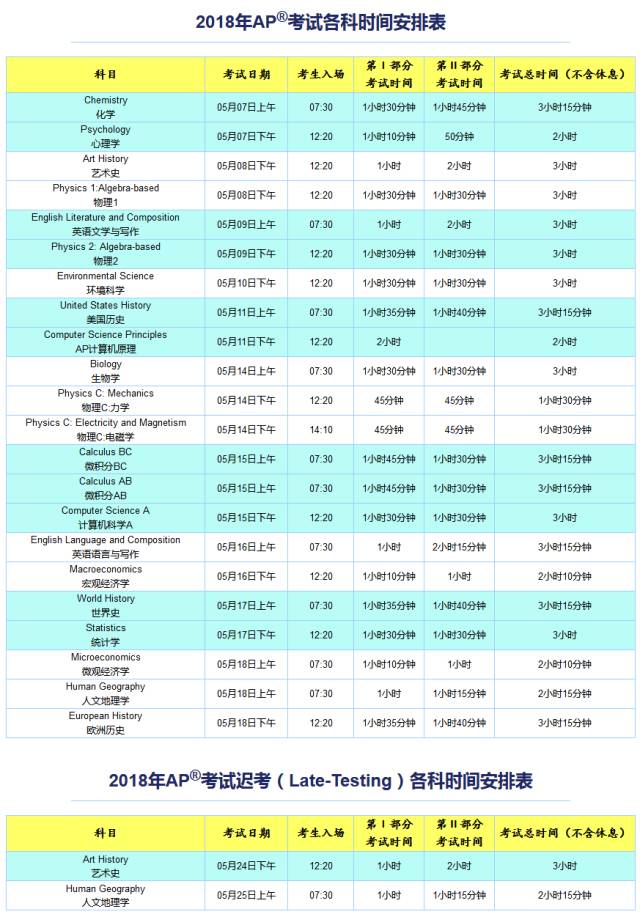
物理1&2考试的题型分为选择题和解答题。
两门考试选择题的数目是一样的,都是50道题,其中包括45道单选题和5道双选题,要在90分钟内答完,占总分值的50%。
物理1的解答题共5道,明确将考察一道实验设计题,一道计算题,三道问答题,要求在90分钟内答完,占总分值的50%
| 题型 | 题目数量 | 考试时间 | 原始分计分原则 | ||
| AP物理1 | 选择题 | 单选题 | 45 | 90 分钟 | 50题*1分/题 =50分 |
| 多选题 | 5 | ||||
| 简答题 | 5 | 90 分钟 | 每道题目分数不等,总计45分 | ||
| 总答题时间180分种 | 原始分总分95分 | ||||
| AP物理2 | 选择题 | 单选题 | 45 | 90分钟 | 50题*1分/题 =50分 |
| 多选题 | 5 | ||||
| 简答题 | 4 | 90分钟 | 每道题目分数不等,总计45分 | ||
| 总答题时间180分种 | 原始分总分95分 | ||||
注:1.多选题有两个正确答案
2.简答题考察1道实验设计题,1道计算题,其余为短问答题(其中一道需要学生进行辩证分析和叙述)。
AP物理1和AP物理2单选题
例1:单选题(含有1个正确答案)
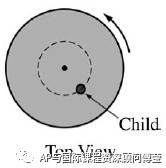
The diagram above shows a top view of achild of mass M on a circular platform of mass 2M that is rotatingcounterclockwise. Assume the platform rotates without friction. Which of thefollowing describes an action by the child that will increase the angular speedof the platform-child system and gives the correct reason why?
(A) The child moves toward the center ofthe platform, increasing the total angular momentum of the system.
(B) The child moves toward the center ofthe platform, decreasing the rotational inertia of the system.
(C) The child moves away from the centerof the platform, increasing the total angular momentum of the system.
(D) The child moves away from the centerof the platform, decreasing the rotational inertia of the system.
答案: B。本题考查的是转动部分的知识:如果系统所受的合外力矩为0,那么系统的角动量不变。本题中,当小孩向中心移动时减小了转动惯量,从而增大系统的角速度。
例2:多选题(含有2个正确答案)
In an experiment, three microscopiclatex spheres are sprayed into a chamber and become charged with +3e, +5e and-3e, respectively. Later, all three spheres collide simultaneously and thenseparate. Which of the following are possible values for the final charges onthe spheres? Select two answers.
X Y Z
(A) +4e -4e +5e
(B) -4e +4.5e +4.5e
(C) +5e -8e +7e
(D) +6e +6e -7e
答案: A D。本题考查的是电荷的基本知识:电荷守恒,系统的净电荷等于所有物体所带电荷的和;电荷的最小单位是元电荷e,物体带电量必须是e的整数倍。
例3:简答题:这部分加大了实验题和文字论述题的比重。其中考察1道实验设计题,1道定量计算和定性论述题,其余为简短问答题。对于实验设计题,通常实验装置和步骤不是唯一的,只要合理可行都可以得到相应的分值。实验步骤不需要长篇大论,一定要清晰、简洁明了。例如:

A groupof students has two carts, A and B, with wheels that turn with negligiblefriction. The carts can travel along a straight horizontal track. Cart A hasknown mass mA. The students are asked to use a one-dimensionalcollision between the carts to determine the mass of cart B. Before thecollision, cart A travels to the right and cart B is initially at rest, asshown above. After the collision, the carts stick together.
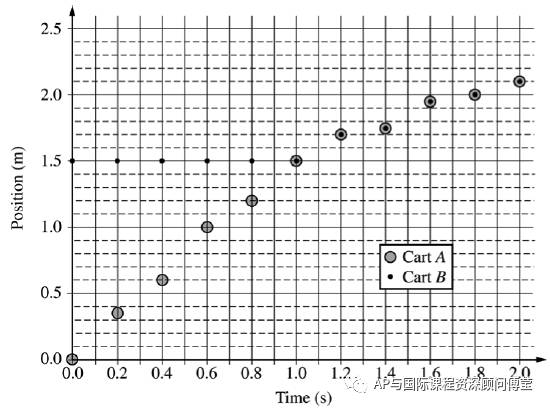
(a) Describean experimental procedure to determine the velocities of the carts before andafter a collision, including all the additional equipment you would need. Youmay include a labeled diagram of your setup to help in your description.Indicate what measurements you would take and how you would take them. Includeenough detail so that another student could carry out your procedure.
(b)There will be sources of error in the measurements taken in the experiment,both before and after the collision. For your experimental procedure, will theuncertainty in the calculated value of the mass of cart B be affected more bythe error in the measurements taken before the collision or by those takenafter the collision, or will it be equally affected by both sets ofmeasurements?
Justifyyour answer.
A group of students took measurementsfor one collision. A graph of the students’ data is shown below.
(c) Given mA=0.50kg, usethe graph to calculate the mass of cart B. Explicitly indicate the principlesused in your calculations.
(d) The students are now asked to consider thekinetic energy changes in an inelastic collision, specifically whether theinitial values of one of the physical quantities affect the fraction ofmechanical energy dissipated in the collision. How could you modify theexperiment to investigate this question? Be sure to explicitly describe thecalculations you would make, specifying all equations you would use (but do notactually do any algebra or arithmetic).
答案:
(a) 评分说明:实验设计题的答案不是唯一的,只要合理可行即可。本题中,须使用合理的实验装置,并明确指出测量碰撞前与碰撞后的速度所需的所有实验步骤。初此之外,须没有其他与实验无关的装置和测量。
参考答案:
Place a motion detector at the left endof the track. Push cart A to give it an initial speed. Record position as afunction of time, first for cart A and then the combined cart A and B.
(b)评分说明:对碰撞前与碰撞后的测量误差给出合理的假设,并根据这些假设对比它们在计算物块B的质量时产生的影响而得出结论。
参考答案:
If the measurement errors are of the same magnitude,they will have a greater effect after the collision. The speed of the combinedcarts will be less than the initial speed of cart A, so errors of the samemagnitude will be a greater percentage of the actual value after the collision.So the values after the collision will have a greater effect on the value ofthe mass of cart B.
(c)
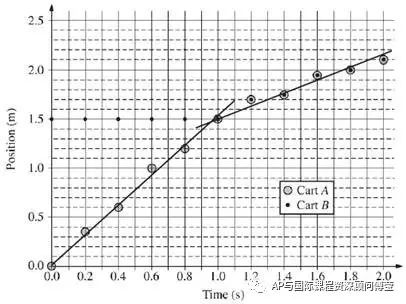
Conservation ofmomentum can be used to determine the mass of cart B:
![]()
The speed vibefore the collision is the slope of the best-fit line for the data from 0 to1s. The speed vfafter the collision is the slope of thebest-fit line for the data from 1 to 2s.

Applying conservation of momentum:

(d) 评分说明:须与(a)中的实验装置和步骤一致,改变其中某个物理量进行实验,根据用测量数据计算碰撞前与碰撞后的动能,通过比较损失的机械能得出结论。
参考答案:
You could vary the initial speed of cart A. From the data, calculatevalues of kinetic energy before and after the collision using
![]()
. Then analyze
![]()
to see if the changes in initial speedgive different values.
由此可见,解答题部分将不再局限于对学生计算能力的考察,而是更注重考察学生的理解能力,文字叙述和书面表达能力。
AP物理1和AP物理2 是2015年AP考试起对物理B考试的改革,把物理B分成了两门考试,它们涵盖范围除了物理B原有的内容(牛顿力学、流体力学、热学、电学、磁学、光学、机械波和原子物理等基本知识)外,还增加了转动力学部分。考核知识在原来物理B的基础上稍有加深,而且还增加了实验部分的比重。AP物理1和AP物理2所需数学知识浅显,只涉及代数方程,我国高中数学足以解决AP物理1和AP物理2考试中的数学要求。由于AP物理1和AP物理2考试涵盖范围很宽,不管学生今后在大学选什么专业都有用。
1. 运动学&牛顿定律
2. 功&能&动量
3. 圆周运动&转动力学
4. 振动&波
5. 电场力&纯电阻电路
物理1考点在简答题中的分布
样题:
第一题:振动和波
第二题:功、能和动能
第三题:运动学和牛顿定律
2015年
第一题:运动学和牛顿定律
第二题:电路
第三题:功、能和动能
第四题:运动学和牛顿定律
第五题:振动和波
2016年:
第一题:振动
第二题:功、能和动能
第三题:运动学和牛顿定律
第四题:电路
第五题:振动和波
详细考点梳理:
1. 运动学&牛顿定律(kinetics,dynamics)
运动学和牛顿定律是力学的基础,往往跟力学的各个章节结合起来,也经常跟电磁学结合起来考查,是考试的重点。
这一部分的主要考点包括
uniformly accelerated motion 匀加速运动
velocity-time diagram 速度-时间图
projectile motion 抛体运动
Newton’s Law 牛顿定律
Free-body diagram 受力分析图
2. 功&能&动量
(work,energy, impulse)
功能这一部分是力学的核心,还特别容易和振动、摆部分综合出题。
其主要考点集中于:
work 功
energy conservation 能量守恒
kinetic and potential energy 动能与势能
the conservation of mechanical energy 机械能守恒
power 功率
impulse 冲量
conservation of linear momentum 动量守恒
elasticand inelastic collision 弹性和非弹性碰撞。
3.圆周运动和转动
(circular motion, rotational motion)
转动原来是只有物理C才考的内容,物理B改革后被加到来物理1的考点中,而且在国内高中转动没有涉猎过,所以这部分内容对大多数学生来说是个难点,但是物理1这部分不会考定量计算,只会考对概念定性的理解,难度并不是太大。
其考点主要有:
Uniformly Circular Motion 匀速圆周运动
Newton’s Law of Gravitation 牛顿万有引力
Torque 力矩
Equilibrium 平衡
Rotational Kinematics 转动运动学
Rotational Dynamics 转动力学
4.振动和波 (oscillation & wave)
振动和波这部分在15和16年的考试中都出了大题,属于考试的重点,而这部分内容又是高中物理所不太涉及到的地方,需要同学们着重复习一下。
主要的考点有:
Simple Harmonic Motion 简谐振动
Pendulum 摆
Traveling waves 行波
Standing waves 驻波
Doppler effect 多普勒效应
这其中驻波是重点,一是在国内高中不太被涉及的到,而且对于初学者理解起来比较抽象。
5.电场力和纯电阻电路
(electrostatics and DC circuits)
这部分知识点在物理1、2的考试中都有涉及,主要是在物理2的考试中出现,在物理1中相对比较简单。
主要涉及的考点有:
Electric Forces 电场力
Electric Fields 电场
Conductor 导体
Ohm’s Law 欧姆定律
Electric power 电功率
例题:
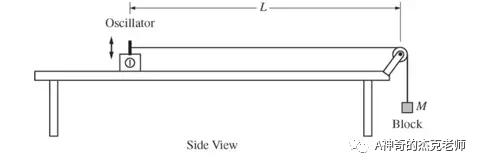
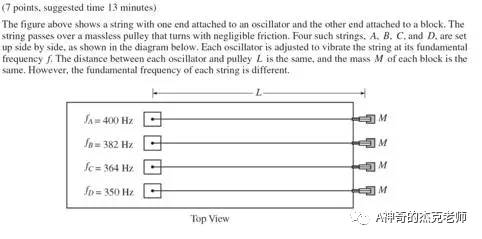

1. 流体力学
2. 热学
3. 电场和电容
4. 直流电路
5. 磁学
6. 光学
7. 近现代物理
物理2考点在简答题中的分布
样题:
第一题:化学+现代物理
第二题:热学
第三题:电、磁
2015年
第一题:光学
第二题:电路
第三题:热学
第四题:电学+磁学
2016年
第一题:热学
第二题:光学
第三题:电场
第四题:电路
简单题中:光学、热学和电学在简单题中频率最高。
1. 流体力学 fluid mechanics
物理改革后流体力学的题明显减少,这减轻了同学们的学习负担。
这一块考点主要有:
Fluid pressure 流体压强
Buoyancy 浮力
FlowRate Equation 径流量方程
Bernoulli’s equation 伯努利定理
需要特别强调的一点是,流体仍然在CB的考察范围内,大家可以少分配些时间在流体这部分内容上,但不能完全忽视。
2. 热学 thermal physics
这部分的考点主要包括以下两点:
IdealGas 理想气体及其状态方程
ThermalDynamics 热力学第一定律。
这两部分内容常常结合在一起出题,学习的过程中P-V图的理解是关键,考前同学们要认真复习一下。
3. 电场和电容 electrostatics
物理1中这部分出题频率较原物理B要多,电学部分又喜欢和磁结合起来出大题,这两年都是,一个电学大题的后一问或者两问是磁学的题,另外需要注意的一点是这部分内容经常结合力学考察,所以物理1力学部分要先学好。
这部分的考点主要包括:
ElectricForce 电场力
ElectricField 电场强度
Conductor& Insulator 导体与绝缘体
ElectricPotential 电势
Capacitance 电容
4.直流电路 Direct Circuits
物理1已经涉及到了纯电阻直流电路,物理2再继续这部分知识时,重点涉及到Resistor-Capacitor电阻-电容电路,也就是咱们常说的RC电路,纯电阻直流电路是国内高中考试的热门考点,相信每一个在国内上过高中的孩子掌握起这部分来都还比较容易,RC电路的内容也考的比较浅,在物理2考试的FR中,这部分的内容应该是比较容易得分的。
5.Magnetism磁学
磁学部分主要的考点是 Magnetic force 磁场力和 Electromagnetic Induction 电磁感应。磁学是国内高考和物理C考试中的热门考点,在原来物理B的考试中,磁学也一直是考试的重点,在跟力学结合起来的时候能出非常难的题目。但是在物理2的考试中,磁学所占的比分大大减少,除了少数几个选择题,在大题中一般是跟电学部分结合起来出大题。
6.光学 geometric and physical optics
光学的知识点比较多,主要包括:
Interference 干涉
Diffraction 衍射
Reflection 反射
Refraction 折射
Dispersion 色散
Spherical Mirrors 球面镜
Lens 透镜
这其中球面镜在国内高中很少能接触到。
7.近现代物理 modern physics
这部分主要考点有:
Photoelectric effect 光电效应
energy level 能级
Wave-particleduality 波粒二象性
nuclear reaction 核反应
最后,祝大家在2018年SAT和AP考试中取得好成绩!

早鸟钜惠!翰林2025暑期班课上线

最新发布
© 2025. All Rights Reserved. 沪ICP备2023009024号-1










